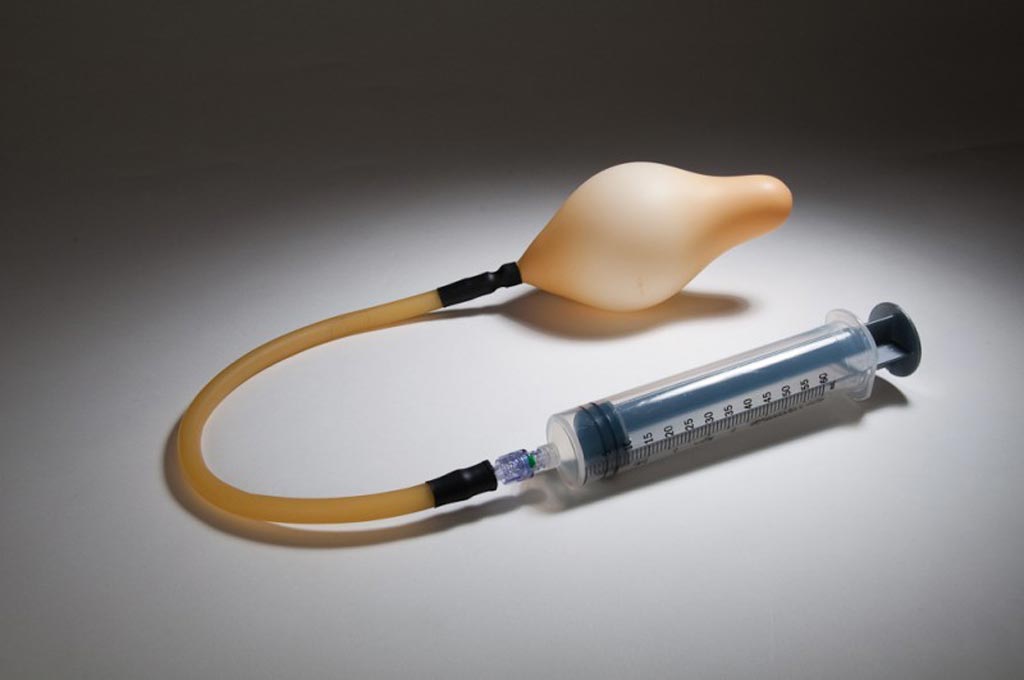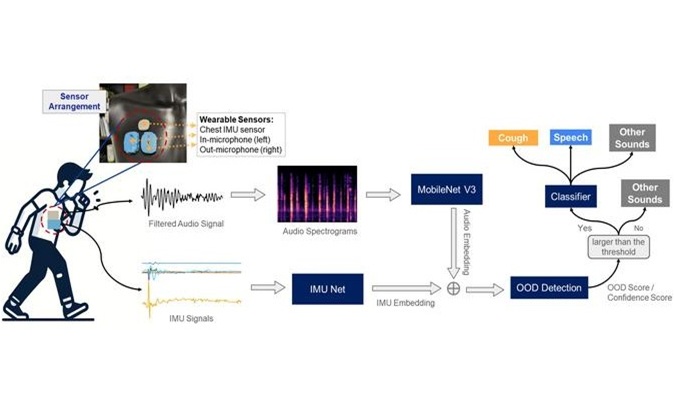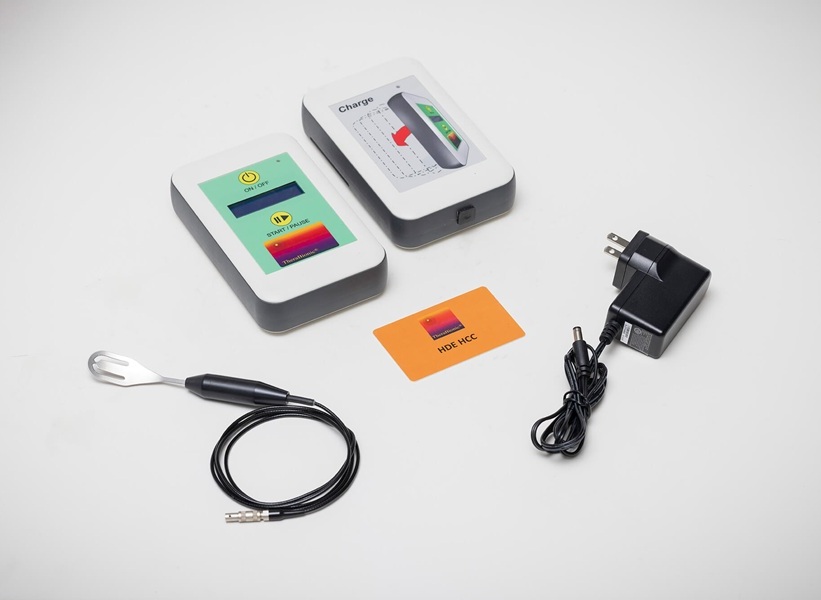Intrauterine Balloon Tamponade Improves Hemorrhage Control
|
By HospiMedica International staff writers Posted on 11 Jan 2018 |

Image: An intrauterine balloon tamponade device (Photo courtesy of Alpha Image).
A new study shows that using an intrauterine balloon is associated with a significantly lower need for invasive procedures for hemorrhage control in women following vaginal delivery.
Researchers at Université de Versailles Saint-Quentin-en-Yvelines (UVSQ; France) conducted a retrospective cohort study that included 72,529 women who delivered a baby during 2011 and 2012 in 19 maternity units in two French perinatal networks; one that routinely used an intrauterine balloon tamponade for postpartum hemorrhage management (study cohort), and another that did not (control). Postpartum outcomes were assessed based on discharge abstract data from the French national medical information system.
The results revealed that invasive procedures were assumed in 298 women, representing 4.1 per 1,000 deliveries. The cohort network had a significantly lower proportion of women with at least one invasive procedure (3/1,000), compared to the control network (5.1/1,000). The study perinatal network also had significantly lower use of arterial embolization for those who delivered vaginally. Risk of an invasive procedure remained significantly lower in the cohort network for women who delivered vaginally, but not for women who delivered by Cesarean section. The study was published on December 4, 2017, in Obstetrics & Gynecology.
“The use of intrauterine balloon tamponade in routine clinical practice is associated with a significantly lower use of invasive procedures among women undergoing vaginal delivery,” concluded lead author Mathilde Revert, MSc, and colleagues. “After controlling for potential confounding factors, the risk of an invasive procedure among women who delivered vaginally remained significantly lower in the pilot network, but not for women who delivered by Cesarean.”
Postpartum hemorrhage is the leading direct cause of maternal death worldwide. Intrauterine balloon tamponade is a minimally invasive intervention that involves inserting a balloon device into the uterus and then incrementally filling it with liquid, which applies pressure to the uterus until the bleeding stops. Even when it cannot completely control severe postpartum hemorrhage, it can still serve a critical role by reducing blood loss until the woman can be transported to a facility with surgical management and other treatment options.
Related Links:
Université de Versailles Saint-Quentin-en-Yvelines
Researchers at Université de Versailles Saint-Quentin-en-Yvelines (UVSQ; France) conducted a retrospective cohort study that included 72,529 women who delivered a baby during 2011 and 2012 in 19 maternity units in two French perinatal networks; one that routinely used an intrauterine balloon tamponade for postpartum hemorrhage management (study cohort), and another that did not (control). Postpartum outcomes were assessed based on discharge abstract data from the French national medical information system.
The results revealed that invasive procedures were assumed in 298 women, representing 4.1 per 1,000 deliveries. The cohort network had a significantly lower proportion of women with at least one invasive procedure (3/1,000), compared to the control network (5.1/1,000). The study perinatal network also had significantly lower use of arterial embolization for those who delivered vaginally. Risk of an invasive procedure remained significantly lower in the cohort network for women who delivered vaginally, but not for women who delivered by Cesarean section. The study was published on December 4, 2017, in Obstetrics & Gynecology.
“The use of intrauterine balloon tamponade in routine clinical practice is associated with a significantly lower use of invasive procedures among women undergoing vaginal delivery,” concluded lead author Mathilde Revert, MSc, and colleagues. “After controlling for potential confounding factors, the risk of an invasive procedure among women who delivered vaginally remained significantly lower in the pilot network, but not for women who delivered by Cesarean.”
Postpartum hemorrhage is the leading direct cause of maternal death worldwide. Intrauterine balloon tamponade is a minimally invasive intervention that involves inserting a balloon device into the uterus and then incrementally filling it with liquid, which applies pressure to the uterus until the bleeding stops. Even when it cannot completely control severe postpartum hemorrhage, it can still serve a critical role by reducing blood loss until the woman can be transported to a facility with surgical management and other treatment options.
Related Links:
Université de Versailles Saint-Quentin-en-Yvelines
Latest Surgical Techniques News
- Novel Glue Prevents Complications After Breast Cancer Surgery
- Breakthrough Brain Implant Enables Safer and More Precise Drug Delivery
- Bioadhesive Sponge Stops Uncontrolled Internal Bleeding During Surgery
- Revolutionary Nano Bone Material to Accelerate Surgery and Healing
- Superior Orthopedic Implants Combat Infections and Quicken Healing After Surgery
- Laser-Based Technique Eliminates Pancreatic Tumors While Protecting Healthy Tissue
- Surgical Treatment of Severe Carotid Artery Stenosis Benefits Blood-Brain Barrier
- Revolutionary Reusable Duodenoscope Introduces 68-Minute Sterilization
- World's First Transcatheter Smart Implant Monitors and Treats Congestion in Heart Failure
- Hybrid Endoscope Marks Breakthrough in Surgical Visualization
- Robot-Assisted Bronchoscope Diagnoses Tiniest and Hardest to Reach Lung Tumors
- Diamond-Titanium Device Paves Way for Smart Implants that Warn of Disease Progression
- 3D Printable Bio-Active Glass Could Serve as Bone Replacement Material
- Spider-Inspired Magnetic Soft Robots to Perform Minimally Invasive GI Tract Procedures
- Micro Imaging Device Paired with Endoscope Spots Cancers at Earlier Stage
- AI Spine Model Could Reduce Surgical Risks
Channels
Critical Care
view channel
Origami Robots to Deliver Medicine Less Invasively and More Effectively
Delivering medicine to ulcers or other internal sites often requires invasive procedures that can disrupt surrounding tissues and lengthen recovery times. Traditional magnetic actuators used in soft robotics... Read more
Improved Cough-Detection Technology Aids Health Monitoring
Coughing serves as an important biomarker for tracking a variety of conditions and can help monitor the progress of respiratory diseases or predict when someone’s asthma is being exacerbated.... Read morePatient Care
view channel
Revolutionary Automatic IV-Line Flushing Device to Enhance Infusion Care
More than 80% of in-hospital patients receive intravenous (IV) therapy. Every dose of IV medicine delivered in a small volume (<250 mL) infusion bag should be followed by subsequent flushing to ensure... Read more
VR Training Tool Combats Contamination of Portable Medical Equipment
Healthcare-associated infections (HAIs) impact one in every 31 patients, cause nearly 100,000 deaths each year, and cost USD 28.4 billion in direct medical expenses. Notably, up to 75% of these infections... Read more
Portable Biosensor Platform to Reduce Hospital-Acquired Infections
Approximately 4 million patients in the European Union acquire healthcare-associated infections (HAIs) or nosocomial infections each year, with around 37,000 deaths directly resulting from these infections,... Read moreFirst-Of-Its-Kind Portable Germicidal Light Technology Disinfects High-Touch Clinical Surfaces in Seconds
Reducing healthcare-acquired infections (HAIs) remains a pressing issue within global healthcare systems. In the United States alone, 1.7 million patients contract HAIs annually, leading to approximately... Read moreHealth IT
view channel
Printable Molecule-Selective Nanoparticles Enable Mass Production of Wearable Biosensors
The future of medicine is likely to focus on the personalization of healthcare—understanding exactly what an individual requires and delivering the appropriate combination of nutrients, metabolites, and... Read moreBusiness
view channel
Philips and Masimo Partner to Advance Patient Monitoring Measurement Technologies
Royal Philips (Amsterdam, Netherlands) and Masimo (Irvine, California, USA) have renewed their multi-year strategic collaboration, combining Philips’ expertise in patient monitoring with Masimo’s noninvasive... Read more
B. Braun Acquires Digital Microsurgery Company True Digital Surgery
The high-end microsurgery market in neurosurgery, spine, and ENT is undergoing a significant transformation. Traditional analog microscopes are giving way to digital exoscopes, which provide improved visualization,... Read more
CMEF 2025 to Promote Holistic and High-Quality Development of Medical and Health Industry
The 92nd China International Medical Equipment Fair (CMEF 2025) Autumn Exhibition is scheduled to be held from September 26 to 29 at the China Import and Export Fair Complex (Canton Fair Complex) in Guangzhou.... Read more














